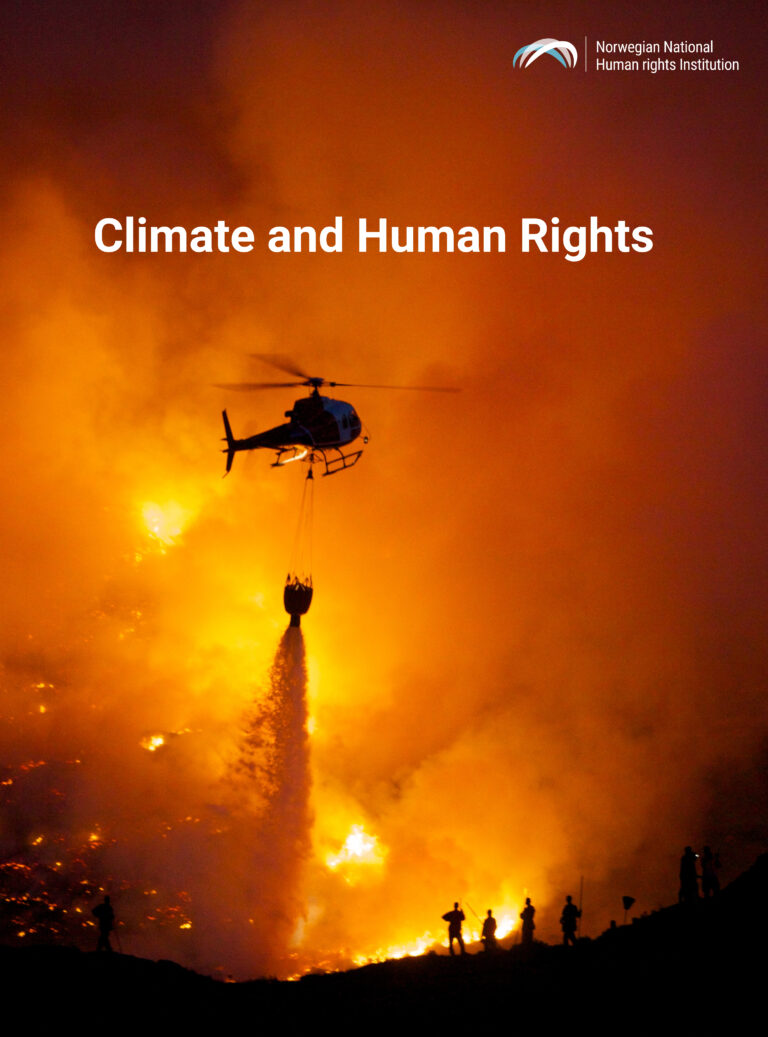
Climate and Human Rights
Contents
- Foreword
- Summary
- 1. Introduction
- 2. From Emissions to Climate risk – Scientific Knowledge Base
- 3. The Link Between Climate Change and Human Rights
- 3.1. Introduction
- 3.2. Three human rights aspects
- 3.2.1. Mitigation of climate change
- 3.2.2. Adaptation to climate change
- 3.2.3. Boundaries to climate action
- 3.3. Key issues when mitigation of climate change is understood from a human rights perspective
- 3.3.1. Politics or law?
- 3.3.2. Future generations as rights-bearers
- 4. Section 112 of the Norwegian Constitution
- 5. The European Convention on Human Rights
- 5.1. Introduction
- 5.2. The ECtHR's interpretation method
- 5.2.1. Legal principles
- 5.2.2. Purpose-oriented interpretation
- 5.2.3. Dynamic interpretation
- 5.2.4. The principle of subsidiarity
- 5.2.5. Principle of margin of appreciation
- 5.2.6. The significance of international and national law
- 5.2.7. Summary
- 5.3. Jurisdiction
- 5.4. Articles 2 and 8 of the ECHR in general
- 5.4.1. Point of departure
- 5.4.2. Relationship between Articles 2 and 8 of the ECHR
- 5.4.3. Precautionary assessment of risk
- 5.5. Does Article 2 of the ECHR apply?
- 5.5.1. Introduction
- 5.5.2. Protection against the general risk to society
- 5.5.3. What does the requirement for a “real and immediate” risk entail?
- 5.5.4. The authorities' knowledge of the risks
- 5.5.5. Summary
- 5.6. Does Article 8 of the ECHR apply?
- 5.6.1. Point of departure
- 5.6.2. Negative and positive obligations in general
- 5.6.3. Does Article 8 of the ECHR cover the latent and future risk of climate change?
- 5.6.4. Summary
- 5.7. Particular questions when applying Articles 2 and 8 of the ECHR to greenhouse gas emissions
- 5.7.1. Can individual States be held accountable for violations caused by multiple States?
- 5.7.2. ECtHR practice
- 5.7.3. Customary international law
- 5.7.4. Specialised rules of international law on greenhouse gas emissions
- 5.7.5. National responsibility rules
- 5.7.6. Objections
- 5.7.7. Summary
- 5.8. Positive obligations relating to climate change risks
- 5.8.1. Overview
- 5.8.2. Substantive element of the positive obligation
- 5.8.3. Procedural element of the positive obligation
- 5.8.4. Summary
- 5.9. Procedural conditions – in particular the victim requirement in Article 34 of the ECHR
- 5.9.1. The significance of procedural conditions in the climate area
- 5.9.2. Overview of the “victim” requirement pursuant to Article 34 of the ECHR
- 5.9.3. Can organisations appeal in their own name against violations that will affect their members?
- 5.9.4. Can individuals appeal to the ECtHR when the legal action has been filed by an organisation?
- 5.9.5. Summary
- 5.10. Summary
- 6. Climate in the UN Human Rights System
- 6.1. Introduction
- 6.2. UN treaty bodies and their practices
- 6.2.1. UN treaty bodies
- 6.2.2. The significance of the treaty bodies' statements
- 6.3. The right to life and the right to private and family life
- 6.3.1. International Covenant on Civil and Political Rights (ICCPR)
- 6.3.2. United Nations Convention on the Rights of the Child
- 6.4. The right to health
- 6.4.1. The UN’s International Covenant on Economic, Social and Cultural Rights (ICESCR)
- 6.4.2. United Nations Convention on the Rights of the Child
- 6.5. Recommendations for Norway from UN treaty bodies and the UN Special Rapporteur
- 6.5.1. Recommendations from the treaty bodies
- 6.5.2. Recommendations from the UN Special Rapporteur on Human Rights and the Environment
- 6.6. Developments
- 7. Procedural Rights
- 7.1. Introduction
- 7.2. Overview of the most important legal sources and institutional arrangements
- 7.3. Participatory rights
- 7.3.1. Right to environmental information
- 7.3.2. Right to participation in decision-making processes
- 7.3.3. Right to effective legal remedies and access to justice
- 7.4. The authorities' duty to investigate
- 7.4.1. According to the rules of international law
- 7.4.2. Section 112, second and third paragraph, of the Constitution
- 8. Climate-Displaced People
- 9. Climate Litigation Based on Human Rights
- 9.1. Introduction
- 9.2. Climate action based on the ECHR
- 9.2.1. The Netherlands
- 9.2.2. Ireland
- 9.2.3. Switzerland
- 9.2.4. Belgium
- 9.2.5. Austria
- 9.2.6. France
- 9.2.7. The European Court of Human Rights
- 9.3. Individual communications about climate based on UN human rights conventions
- 9.3.1. New Zealand
- 9.3.2. Australia
- 9.3.3.Argentina, et al.
- 9.4. Climate action based on the EU’s Charter of Fundamental Rights
- 9.5. Selected climate actions based on national legal rules
- 9.5.1. United Kingdom
- 9.5.2. Germany
- 9.5.3. Poland
- 9.6. General trends and developments
- 10. The Way Forward
- Reference List
- Laws and regulations
- Preparatory work for laws, public investigations and parliamentary documents
- Supreme Court decisions
- Decisions from Norwegian sub-authorities
- Statements from other Norwegian government agencies
- Decisions from other national courts
- International conventions and declarations
- Decisions of the European Court of Human Rights (ECtHR)
- Statements and reports from European human rights bodies
- Statements, reports and decisions from UN agencies
- Books
- Anthology articles
- Journal articles
- Reports
- Websites
- Media articles
- Other sources
- Photo credits
- Published:
- Show report on one page